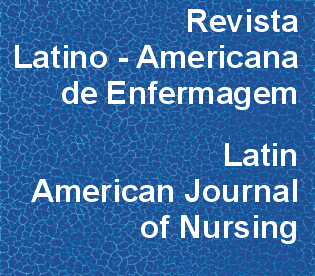Avaliação da qualidade da técnica de higiene das mãos em alunos de enfermagem e medicina em dois cursos de graduação
DOI:
https://doi.org/10.1590/0104-1169.0459.2607Resumo
Objetivo:assim como as mãos dos professionais de saúde, as mãos dos estudantes de Enfermagem e Medicina durante os estágios clínicos podem funcionar como veículo de transmissão das infecções hospitalares.Método:estudo descritivo com estudantes de Graduação em Enfermagem e Medicina. Avaliou-se a qualidade da técnica de higiene das mãos por meio de prova visual a partir de solução hidro-alcoólica marcada com fluoresceína e lâmpada de luz ultravioleta.Resultados:avaliaram-se 546 alunos, 73,8% da Graduação em Medicina e 26,2% da Enfermagem. As áreas das mãos com correta distribuição de sabão foram as palmas (92,9%); as áreas não esfregadas corretamente foram os polegares (55,1%). Em ambas as mãos, a higienização foi muito boa em 24,7%, boa em 29,8%, regular em 25,1% e má em 20,3%. Os piores foram: os homens, os estudantes de Enfermagem e os estudantes do primeiro ano de escola. Não houve diferenças significativas por idade.Conclusões:a técnica de higiene de mãos não foi realizada de modo eficaz. O papel educativo é fundamental para sedimentar as bases de boas práticas na higienização das mãos, em conhecimentos teóricos e no desenvolvimento de habilidades e reforço de boas práticasDownloads
Os dados de download ainda não estão disponíveis.
Downloads
Publicado
2015-08-01
Edição
Seção
Artigos Originais
Licença
Os direitos autorais são de propriedade exclusiva da revista, transferidos por meio da Declaração de Transferência de Direitos Autorais (presente no Formulário Individual de Declarações) assinada pelos autores. Para a utilização dos artigos, a RLAE adota a Licença Creative Commons, CC BY-NC Atribuição não comercial (resumo ou código completo da licença). Com essa licença é permitido acessar, baixar (download), copiar, imprimir, compartilhar, reutilizar e distribuir os artigos, desde que para uso não comercial e com a citação da fonte, conferindo os devidos créditos autorais a Revista Latino-Americana de Enfermagem. Nesses casos, nenhuma permissão é necessária por parte dos autores ou dos editores.Como Citar
Avaliação da qualidade da técnica de higiene das mãos em alunos de enfermagem e medicina em dois cursos de graduação . (2015). Revista Latino-Americana De Enfermagem, 23(4), 708-717. https://doi.org/10.1590/0104-1169.0459.2607



